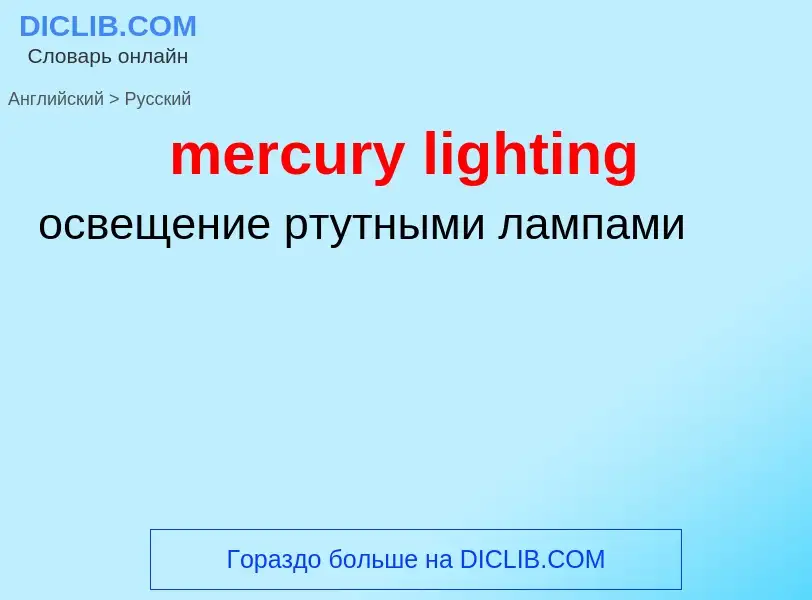Translation and analysis of words by ChatGPT artificial intelligence
On this page you can get a detailed analysis of a word or phrase, produced by the best artificial intelligence technology to date:
- how the word is used
- frequency of use
- it is used more often in oral or written speech
- word translation options
- usage examples (several phrases with translation)
- etymology
mercury lighting - translation to russian
[hai'drɑ:dʒirəm]
общая лексика
ртуть (Hg)
существительное
химия
ртуть
[mə:'kju(ə)rik]
общая лексика
ртуть
Смотрите также
прилагательное
химия
содержащий двухвалентную ртуть
Definition
Wikipedia

A mercury-vapor lamp is a gas-discharge lamp that uses an electric arc through vaporized mercury to produce light. The arc discharge is generally confined to a small fused quartz arc tube mounted within a larger soda lime or borosilicate glass bulb. The outer bulb may be clear or coated with a phosphor; in either case, the outer bulb provides thermal insulation, protection from the ultraviolet radiation the light produces, and a convenient mounting for the fused quartz arc tube.
Mercury vapor lamps are more energy efficient than incandescent lamps with luminous efficacies of 35 to 55 lumens/watt. Their other advantages are a long bulb lifetime in the range of 24,000 hours and a high intensity, clear white light output. For these reasons, they are used for large area overhead lighting, such as in factories, warehouses, and sports arenas as well as for streetlights. Clear mercury lamps produce a greenish light due to mercury's combination of spectral lines. This is not flattering to human skin color, so such lamps are typically not used in retail stores. "Color corrected" mercury bulbs overcome this problem with a phosphor on the inside of the outer bulb that emits at the red wavelengths, offering whiter light and better color rendition.
Mercury vapor lights operate at an internal pressure of around one atmosphere and require special fixtures, as well as an electrical ballast. They also require a warm-up period of four to seven minutes to reach full light output. Mercury vapor lamps are becoming obsolete due to the higher efficiency and better color balance of metal halide lamps.





![Mercury [[manometer]] to measure pressure Mercury [[manometer]] to measure pressure](https://commons.wikimedia.org/wiki/Special:FilePath/Barometer mercury column hg.jpg?width=200)
.jpg?width=200)

![Native mercury with [[cinnabar]], Socrates mine, [[Sonoma County, California]]. Cinnabar sometimes alters to native mercury in the oxidized zone of mercury deposits. Native mercury with [[cinnabar]], Socrates mine, [[Sonoma County, California]]. Cinnabar sometimes alters to native mercury in the oxidized zone of mercury deposits.](https://commons.wikimedia.org/wiki/Special:FilePath/Mercury-27128.jpg?width=200)


![pound coin]] (density ~7.6 g/cm<sup>3</sup>) floats on mercury due to the combination of the [[buoyant force]] and [[surface tension]]. pound coin]] (density ~7.6 g/cm<sup>3</sup>) floats on mercury due to the combination of the [[buoyant force]] and [[surface tension]].](https://commons.wikimedia.org/wiki/Special:FilePath/Pound-coin-floating-in-mercury.jpg?width=200)
![The deep violet glow of a mercury vapor discharge in a [[germicidal lamp]], whose spectrum is rich in invisible ultraviolet radiation. The deep violet glow of a mercury vapor discharge in a [[germicidal lamp]], whose spectrum is rich in invisible ultraviolet radiation.](https://commons.wikimedia.org/wiki/Special:FilePath/Germicidal UV discharge tube glow rotate.jpg?width=200)
![Skin tanner containing a low-pressure mercury vapor lamp and two infrared lamps, which act both as light source and [[electrical ballast]] Skin tanner containing a low-pressure mercury vapor lamp and two infrared lamps, which act both as light source and [[electrical ballast]]](https://commons.wikimedia.org/wiki/Special:FilePath/Mercuryvaporlamp.jpg?width=200)

![The miniaturized [[Deep Space Atomic Clock]] is a linear ion-trap-based mercury ion clock, designed for precise and real-time radio navigation in deep space. The miniaturized [[Deep Space Atomic Clock]] is a linear ion-trap-based mercury ion clock, designed for precise and real-time radio navigation in deep space.](https://commons.wikimedia.org/wiki/Special:FilePath/Deep Space Atomic Clock-DSAC.jpg?width=200)
